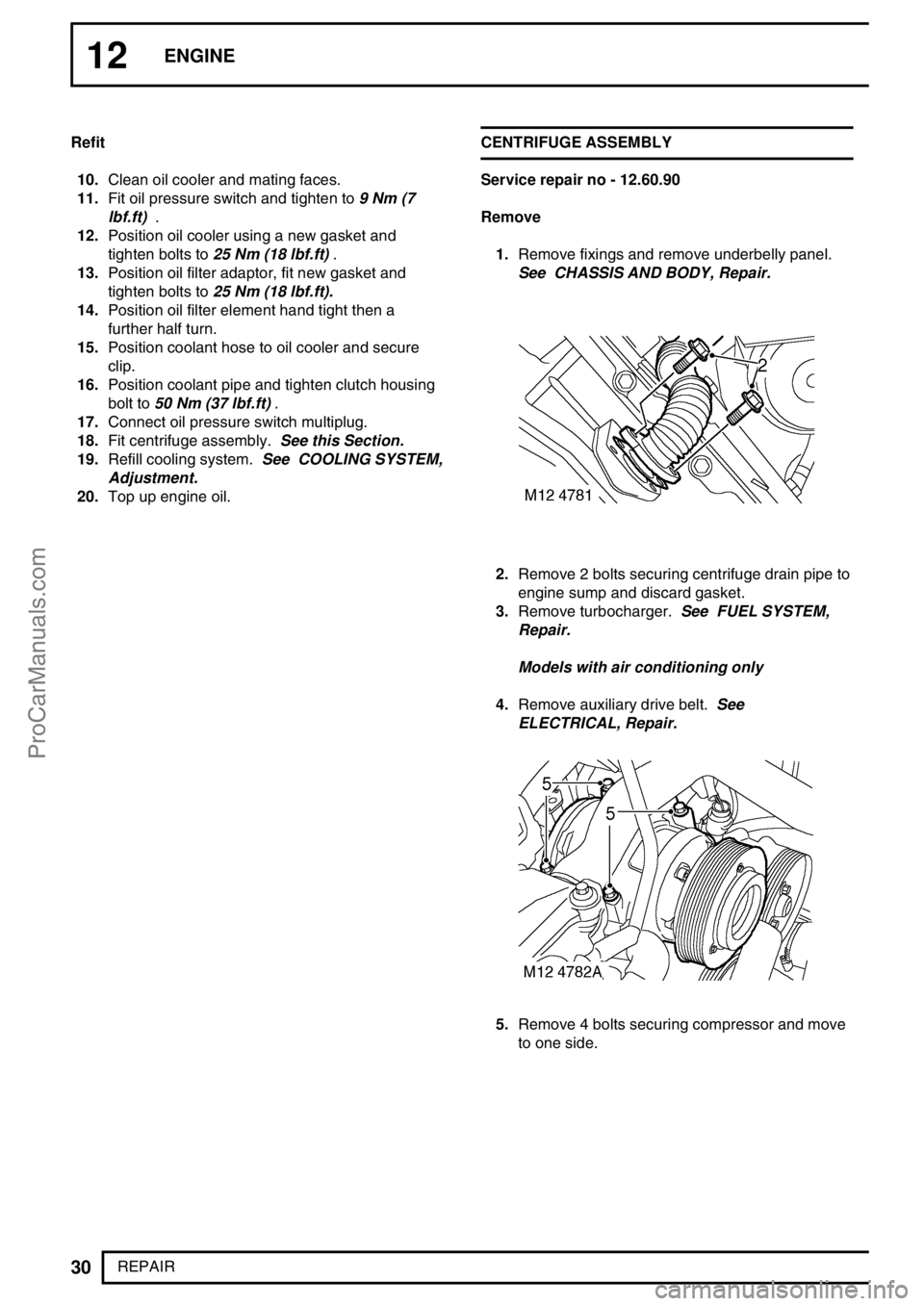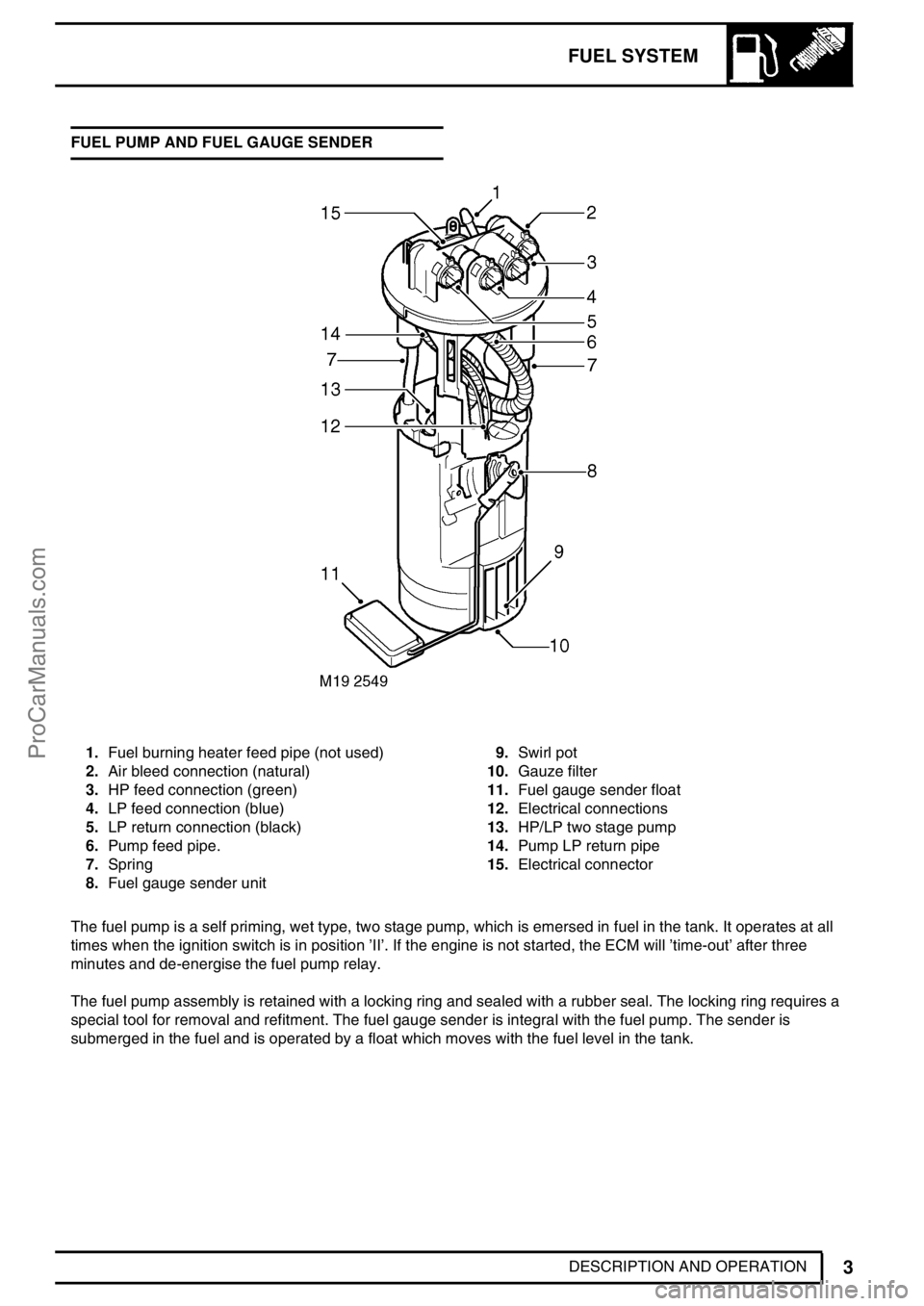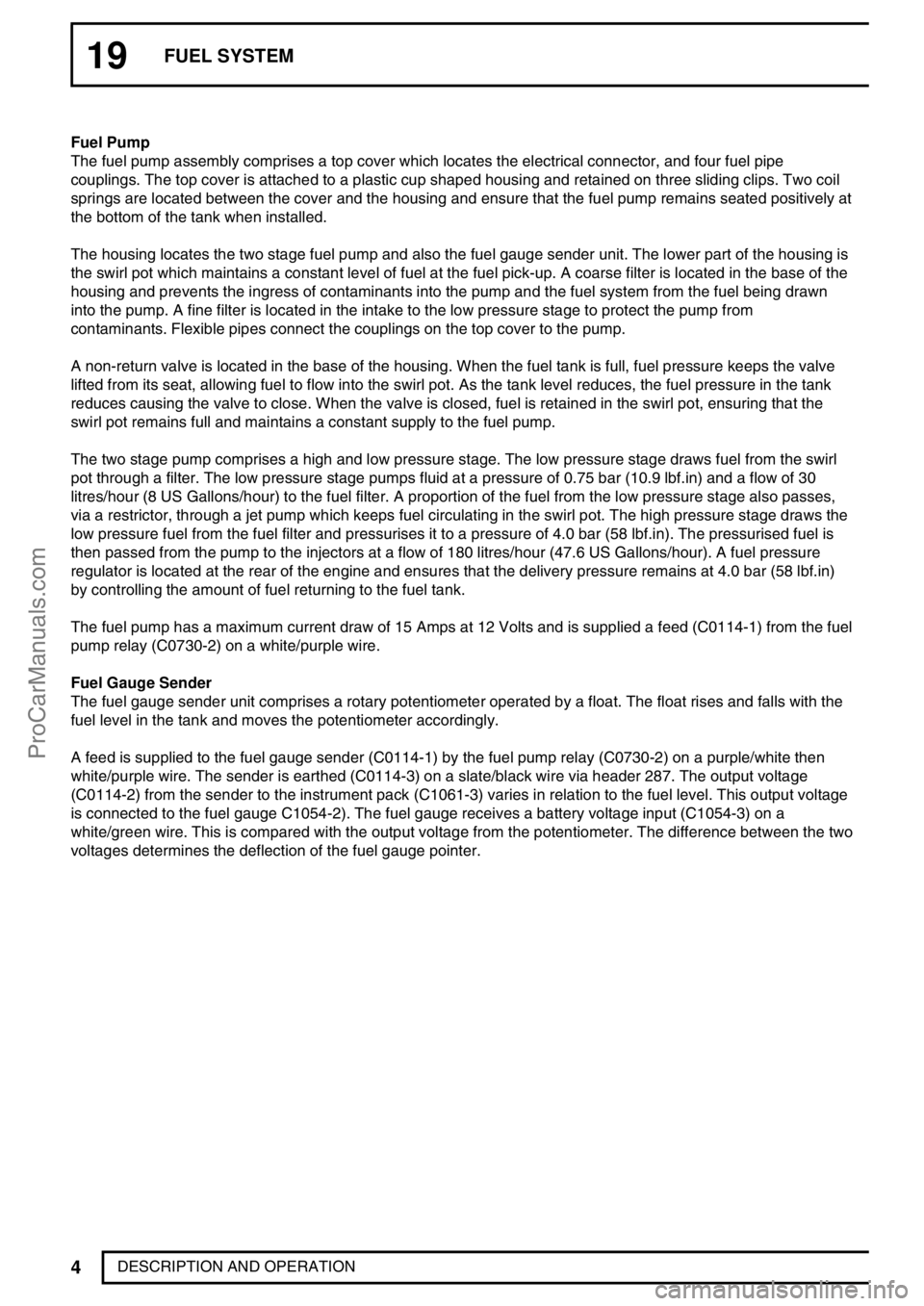fuel filter LAND ROVER DEFENDER 1999 User Guide
[x] Cancel search | Manufacturer: LAND ROVER, Model Year: 1999, Model line: DEFENDER, Model: LAND ROVER DEFENDER 1999Pages: 667, PDF Size: 8.76 MB
Page 145 of 667

12ENGINE
20
REPAIR Refit
9.Fit shield to mounting ensuring cut-away portion
is correctly aligned.
10.Fit mounting and mounting bracket.
11.Fit mounting bracket to cylinder block bolts and
tighten to48 Nm (35 lbf.ft).
12.Fit nuts securing mounting to chassis and tighten
to85 Nm (63 lbf.ft).
13.Fit mounting to mounting bracket nut and tighten
to85 Nm (63 lbf.ft).
14.Remove engine support chains.
15.Clean oil filter adaptor housing and mating face.
16.Fit oil filter adaptor housing using a new gasket
and tighten bolts to25 Nm (18 lbf.ft).
17.Fit centrifuge assembly.See this Section.MOUNTING - FRONT - RH
Service repair no - 12.45.03
Remove
1.Remove engine acoustic cover.See this
Section.
2.Remove fixings, remove battery cover.
3.Disconnect battery negative lead.
4.Raise front of vehicle.
WARNING: Support on safety stands.
5.Remove 4 bolts, move fuel cooler to one side.
6.Fit suitable lifting chains to support engine.
7.Remove 2 nuts securing engine mounting to
chassis.
8.Remove 4 bolts securing engine mounting
bracket to cylinder block.
9.Remove nut securing mounting to mounting
bracket.
10.Remove mounting and mounting bracket.
ProCarManuals.com
Page 155 of 667

12ENGINE
30
REPAIR Refit
10.Clean oil cooler and mating faces.
11.Fit oil pressure switch and tighten to9Nm(7
lbf.ft).
12.Position oil cooler using a new gasket and
tighten bolts to25 Nm (18 lbf.ft).
13.Position oil filter adaptor, fit new gasket and
tighten bolts to25 Nm (18 lbf.ft).
14.Position oil filter element hand tight then a
further half turn.
15.Position coolant hose to oil cooler and secure
clip.
16.Position coolant pipe and tighten clutch housing
bolt to50 Nm (37 lbf.ft).
17.Connect oil pressure switch multiplug.
18.Fit centrifuge assembly.See this Section.
19.Refill cooling system.See COOLING SYSTEM,
Adjustment.
20.Top up engine oil.CENTRIFUGE ASSEMBLY
Service repair no - 12.60.90
Remove
1.Remove fixings and remove underbelly panel.
See CHASSIS AND BODY, Repair.
2.Remove 2 bolts securing centrifuge drain pipe to
engine sump and discard gasket.
3.Remove turbocharger.See FUEL SYSTEM,
Repair.
Models with air conditioning only
4.Remove auxiliary drive belt.See
ELECTRICAL, Repair.
5.Remove 4 bolts securing compressor and move
to one side.
ProCarManuals.com
Page 170 of 667

ENGINE
11
OVERHAUL
23.Remove 3 bolts and remove fuel connector
block from cylinder head.
24.Remove and discard gasket,’O’ring and fuel
filter.
25.Remove spacer block and gasket (if fitted).Cylinder head and camshaft carrier - cleaning
1.Thoroughly clean cylinder head mating faces,
ensure oil and coolant passages are clear and
bolt holes are clean and dry.
CAUTION: Take care to ensure that EUI
drillings are clear.
2.Using suitable solvent, remove all traces of
sealant and gasket material.
CAUTION: Do not use metal scrapers.
3.Remove all traces of oil from camshaft bearings
and journals.
4.Clean glow plug threads.
Cylinder head - Inspection
1.Check core plugs for signs of leakage and
corrosion, seal replacement plugs with Loctite
243.
2.Check cylinder head for warping across centre
and from corner to corner.
Maximum cylinder head warp =0.1 mm (0.004
in).
CAUTION: Cylinder heads may not be
refaced, replace the head assembly if
warping exceeds the limit given.
ProCarManuals.com
Page 178 of 667

ENGINE
19
OVERHAUL 16.Lubricate finger followers with engine oil.
17.Fit finger followers ensuring they are in their
original fitted order.
18.Lubricate cams and bearing journals on
camshaft, cylinder head and camshaft carrier
with engine oil.
19.Position camshaft in cylinder head with the
timing pin hole in the vertical position.
20.Apply an even film of sealant, Part No. STC
4600 to camshaft carrier face and spread to an
even film using a roller.
CAUTION: Ensure sealant does not block
oilways (arrowed) or contaminate
camshaft bearings. Assembly and bolt
tightening must be completed within 20 minutes
of applying sealant.
21.Fit camshaft carrier ensuring it is correctly
located on dowels.
22.Fit and lightly tighten new camshaft carrier bolts.
23.Using sequence shown, progressively tighten
bolts to25 Nm (18 lbf.ft).
24.Lubricate a new camshaft rear oil seal with
engine oil, fit seal using a suitable mandrel.
25.Position rocker shaft on camshaft carrier,
ensuring rocker shaft is located on dowel.
26.Fit new rocker shaft retaining bolts and working
from the centre outwards, tighten bolts
progressively to32 Nm (24 lbf.ft).27.Lubricate a new’O’ring with engine oil and fit to
injector harness multiplug.
28.Fit injector harness and connect multiplugs.
29.Clean fuel connector block and mating face.
30.Lubricate a new fuel filter’O’ring with engine oil.
31.Fit new fuel filter,’O’ring and gasket.
CAUTION: Gasket must be fitted dry.
32.Fit fuel connector block spacer and gasket (if
fitted).
33.Fit fuel connector block, fit bolts and tighten to
25 Nm (18 lbf.ft).
34.Clean glow plugs.
35.Fit glow plugs to cylinder head and tighten to16
Nm (12 lbf.ft).
36. Engine Serial No. Prefixes 15P to 19P:-
Lubricate new’O’rings with engine oil and fit to
spill return pipe; fit pipe and tighten connectors
to20 Nm (15 lbf.ft).
37.Fit new cylinder head gasket.See this Section.
CAUTION: Ensure that the fuel injector
rockers are adjusted following the
procedures given in Gasket - Cylinder
head - Refit.
ProCarManuals.com
Page 254 of 667

19 - FUEL SYSTEM
CONTENTS
Page
DESCRIPTION AND OPERATION
COMPONENT LOCATION 1...................................................................................
DESCRIPTION 2.....................................................................................................
FUEL PUMP AND FUEL GAUGE SENDER 3........................................................
FUEL PRESSURE REGULATOR 5........................................................................
INJECTORS 7.........................................................................................................
FUEL FILTER 9.......................................................................................................
WATER SENSOR 10..............................................................................................
OPERATION 11......................................................................................................
ADJUSTMENT
HEATER PLUG TEST 1..........................................................................................
FUEL SYSTEM - BLEED 1.....................................................................................
FUEL TANK - DRAIN 2...........................................................................................
REPAIR
ELEMENT - AIR FILTER 1......................................................................................
SENSOR - FUEL TEMPERATURE 1......................................................................
SWITCH - INERTIA - FUEL CUT OFF 2.................................................................
SENSOR - MASS AIR FLOW (MAF) 2....................................................................
SENSOR - COMBINED MAP AND IAT 3................................................................
SENSOR - AMBIENT AIR PRESSURE (AAP) 3.....................................................
ELEMENT - FUEL FILTER 4...................................................................................
COOLER - FUEL 4..................................................................................................
TURBOCHARGER 5...............................................................................................
FILTER ASSEMBLY - AIR 6...................................................................................
INJECTOR - SET 7.................................................................................................
HEATER PLUGS - SET 9.......................................................................................
INTERCOOLER 9...................................................................................................
POTENTIOMETER - THROTTLE 10......................................................................
PUMP - FUEL 10.....................................................................................................
REGULATOR - FUEL PRESSURE 11....................................................................
FUEL TANK 12.......................................................................................................
NECK - FUEL TANK FILLER 14.............................................................................
ProCarManuals.com
Page 256 of 667

FUEL SYSTEM
1
DESCRIPTION AND OPERATION COMPONENT LOCATION
1.HP stage
2.LP stage
3.Filters
4.Jet pump
5.Fuel pump and fuel gauge sender unit
6.LP return connection
7.LP feed connection8.HP feed connection
9.Air bleed connection
10.Fuel filter
11.Water sensor
12.Fuel cooler
13.Fuel pressure regulator
14.Electronic Unit Injectors
ProCarManuals.com
Page 257 of 667

19FUEL SYSTEM
2
DESCRIPTION AND OPERATION DESCRIPTION
General
The fuel delivery system comprises a fuel tank, fuel pump, fuel pressure regulator, five injectors and a fuel filter.
The system is controlled by the ECM, which energises the fuel pump relay and controls the operation and timing
of each injector solenoid.
Unlike other Diesel engines, the Td5 has no injection pump. The diesel direct injection system receives fuel at
pressure from a two stage fuel pump located in the fuel tank. The system incorporates a fuel return to the fuel
pump, via a fuel cooler attached to the inlet manifold, and a fuel filter. A fuel pressure regulator is located in a
housing on the rear of the cylinder head. The regulator maintains the fuel delivered to the injectors at a constant
pressure and returns excess fuel back to the fuel filter and pump via the fuel cooler.
A fuel filter is positioned on the chassis longitudinal, below the RH rear wheel arch. The fuel feed and return to and
from the engine passes through the filter. The filter also incorporates a water sensor, which illuminates a warning
lamp in the instrument pack.
A moulded fuel tank is located at the rear underside of the vehicle between the chassis longitudinals. The tank
provides the attachment for the fuel pump and the fuel gauge sender unit, which is located inside the tank.
Fuel Tank and Breather
The fuel tank and breather system is a major part of the fuel delivery system. The fuel tank and breathers are
located at the rear of the vehicle between the chassis longitudinals.
Fuel Tank
The moulded fuel tank is made from High Molecular Weight (HMW) High Density Polyethylene (HDPE), and is
manufactured using a proportion of recycled plastic.
The tank is held in position by a metal cradle which is secured to the chassis cross members by four bolts, two
holding the front of the cradle in position, two holding the rear. The fuel tank has a useable capacity of 75 litres
(16.5 gallons).
An aperture in the top surface of the tank allows for the fitment of the fuel pump and fuel gauge sender unit, which
is retained with a locking ring. A reflective metallic covering is attached to the tank with three scrivets to shield the
tank from heat generated by the exhaust system.
Fuel Tank Breather System
The fuel tank filler tube incorporates a tank vent which allows air and fuel vapour displaced from the tank when
filling to vent to atmosphere via the filler neck.
A breather spout within the tank controls the tank’Full’height. When fuel covers the spout it prevents fuel vapour
and air from escaping from the tank. This causes the fuel to’back-up’in the filler tube and shuts off the filler gun.
The position of the spout ensures that when the filler gun shuts off, a vapour space of approximately 10% of the
tanks total capacity remains. The vapour space ensures that the Roll Over Value (ROV) is always above the fuel
level and vapour can escape and allow the tank to breathe.
The ROV is welded to the top surface of the tank. It is connected by a tube to the filler tube, which in turn is
connected to the atmospheric vent pipe. The ROV allows fuel vapour to pass through it during normal vehicle
operation. In the event of the vehicle being overturned the valve shuts off, sealing the tank and preventing fuel
from spilling from the atmospheric vent pipe.
ProCarManuals.com
Page 258 of 667

FUEL SYSTEM
3
DESCRIPTION AND OPERATION FUEL PUMP AND FUEL GAUGE SENDER
1.Fuel burning heater feed pipe (not used)
2.Air bleed connection (natural)
3.HP feed connection (green)
4.LP feed connection (blue)
5.LP return connection (black)
6.Pump feed pipe.
7.Spring
8.Fuel gauge sender unit9.Swirl pot
10.Gauze filter
11.Fuel gauge sender float
12.Electrical connections
13.HP/LP two stage pump
14.Pump LP return pipe
15.Electrical connector
The fuel pump is a self priming, wet type, two stage pump, which is emersed in fuel in the tank. It operates at all
times when the ignition switch is in position’II’. If the engine is not started, the ECM will’time-out’after three
minutes and de-energise the fuel pump relay.
The fuel pump assembly is retained with a locking ring and sealed with a rubber seal. The locking ring requires a
special tool for removal and refitment. The fuel gauge sender is integral with the fuel pump. The sender is
submerged in the fuel and is operated by a float which moves with the fuel level in the tank.
ProCarManuals.com
Page 259 of 667

19FUEL SYSTEM
4
DESCRIPTION AND OPERATION Fuel Pump
The fuel pump assembly comprises a top cover which locates the electrical connector, and four fuel pipe
couplings. The top cover is attached to a plastic cup shaped housing and retained on three sliding clips. Two coil
springs are located between the cover and the housing and ensure that the fuel pump remains seated positively at
the bottom of the tank when installed.
The housing locates the two stage fuel pump and also the fuel gauge sender unit. The lower part of the housing is
the swirl pot which maintains a constant level of fuel at the fuel pick-up. A coarse filter is located in the base of the
housing and prevents the ingress of contaminants into the pump and the fuel system from the fuel being drawn
into the pump. A fine filter is located in the intake to the low pressure stage to protect the pump from
contaminants. Flexible pipes connect the couplings on the top cover to the pump.
A non-return valve is located in the base of the housing. When the fuel tank is full, fuel pressure keeps the valve
lifted from its seat, allowing fuel to flow into the swirl pot. As the tank level reduces, the fuel pressure in the tank
reduces causing the valve to close. When the valve is closed, fuel is retained in the swirl pot, ensuring that the
swirl pot remains full and maintains a constant supply to the fuel pump.
The two stage pump comprises a high and low pressure stage. The low pressure stage draws fuel from the swirl
pot through a filter. The low pressure stage pumps fluid at a pressure of 0.75 bar (10.9 lbf.in) and a flow of 30
litres/hour (8 US Gallons/hour) to the fuel filter. A proportion of the fuel from the low pressure stage also passes,
via a restrictor, through a jet pump which keeps fuel circulating in the swirl pot. The high pressure stage draws the
low pressure fuel from the fuel filter and pressurises it to a pressure of 4.0 bar (58 lbf.in). The pressurised fuel is
then passed from the pump to the injectors at a flow of 180 litres/hour (47.6 US Gallons/hour). A fuel pressure
regulator is located at the rear of the engine and ensures that the delivery pressure remains at 4.0 bar (58 lbf.in)
by controlling the amount of fuel returning to the fuel tank.
The fuel pump has a maximum current draw of 15 Amps at 12 Volts and is supplied a feed (C0114-1) from the fuel
pump relay (C0730-2) on a white/purple wire.
Fuel Gauge Sender
The fuel gauge sender unit comprises a rotary potentiometer operated by a float. The float rises and falls with the
fuel level in the tank and moves the potentiometer accordingly.
A feed is supplied to the fuel gauge sender (C0114-1) by the fuel pump relay (C0730-2) on a purple/white then
white/purple wire. The sender is earthed (C0114-3) on a slate/black wire via header 287. The output voltage
(C0114-2) from the sender to the instrument pack (C1061-3) varies in relation to the fuel level. This output voltage
is connected to the fuel gauge C1054-2). The fuel gauge receives a battery voltage input (C1054-3) on a
white/green wire. This is compared with the output voltage from the potentiometer. The difference between the two
voltages determines the deflection of the fuel gauge pointer.
ProCarManuals.com
Page 260 of 667

FUEL SYSTEM
5
DESCRIPTION AND OPERATION FUEL PRESSURE REGULATOR
NOTE: Non EU3 Model illustrated.
1.Gasket
2.Housing
3.Bolt
4.Fuel feed union and pipe
5.Fuel return union and hose
6.Fuel temperature sensor
7.Bonded seal8.’O’ring
9.Circlip
10.Fuel pressure regulator
11.’O’ring
12.’O’ring
13.Gauze filter
The fuel pressure regulator is located in a cast alloy housing which is attached to the rear right hand corner of the
cylinder head with three flanged bolts and sealed with a metal gasket. Two ports in the housing connect with ports
in the cylinder head for fuel pressure feed and return. A gauze filter is located in the pressure feed port in the
cylinder head, and filters the fuel before it reaches the injectors. The filter is a fit for life item but can be changed if
required. An’O’ring is located in a recess in the cylinder head and provides additional sealing for the pressure
feed port between the gauze filter, the cylinder head, and the housing.
A union and pipe is attached to the feed port in the housing and connects with a quick release coupling to the fuel
pressure feed pipe from the fuel pump. A second union and hose is located in the return port and provides the fuel
return connection to the fuel cooler. A third port provides location for the fuel temperature sensor, which is sealed
to the housing with a bonded seal. The fuel temperature sensor is used by the ECM for engine management.
ProCarManuals.com